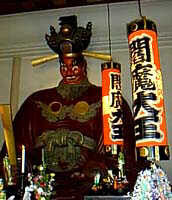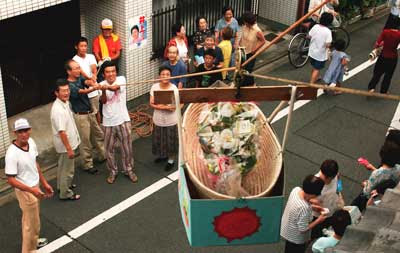. Heaven 極楽 gokuraku and Hell 地獄 jigoku .
:::::::::::::::::::::::::::::::::::::::::::::::::::::::::::::::::::::::::::::::::::::::::::::::::::
Enma, Emma, the King of Hell
***** Location: Japan
***** Season: See below.
***** Category: Observation
*****************************
Explanation
Emma (Enma ten, Enma Oo) 閻魔天、閻魔王
Sanskrit : Yama or Yama-raja.
King of the Underworld; chief judge in the afterlife; when a person dies, s/he must appear before Enma (and also before other judges), who decides whether the person is good or bad; the person is then sent to the most appropriate afterworld; among the judges of hell, Enma is the most important.
Read Mark Schumacher

- reference source : Bando Kannon 20 第二十番 獨鈷山西明寺 -
. Laughing Enma at 西明寺 Saimyo-Ji, Mashiko .
Click HERE for more photos !
................................................................................

Proverbs with Enma !
嘘をつくと閻魔さまに舌を抜かれる
"If you lie, Lord Enma will pull out your tongue."
A superstition often told to scare children into telling the truth.
借りる時の地蔵顔、返す時の閻魔顔
"When borrowing, the face of a Jizo;
when repaying (a loan), the face of Enma.
This alludes to changes in people's behaviour for selfish reasons depending on their circumstances.
:::::::::::::::::::::::::::::::::::::::::::::::::::::::::::::::::::::::::::::::::::::::::::::::::::
His regular memorial day is the 16th of each month.

In January and July, Emma (Enma, Ema) is out on a holiday (Emma saijitsu 閻魔賽日(えんま さいじつ) and the lid to the chauldron of hell was closed 地獄の釜の蓋が開く日, so these two days are best to visit a temple where Emma is enshrined (Emmadoo 閻魔堂).
During the Edo period, this day was also called yabu-iri 籔入り, a day when the servants and wifes of workers at shops and stores had a day off to visit their families and the local Ema temples.
I used to practise Japanese Archery at the small Enma-Doo Hall in the compounds of Temple Engaku-Ji in Kita Kamakura. We had to greet King Enma before starting the pracsise and were sure he would supervise everything we did. This gave the daily practise an extra bit of severity.
Gabi Greve

More about the Enma Do Hall 閻魔堂 and Temple in Kamakura
Enno-Ji 円応寺
Ennoji temple: The King of Hell
Click HERE for photos of Enma Halls (Enma doo 閻魔堂) !
:::::::::::::::::::::::::::::::::::::::::::::::::::::::::::::::::::::::::::::::::::::::::::::::::::
Kigo for Early Summer
. Enmadoo dainenbutsu 閻魔堂大念仏 (えんまどうだいねんぶつ)
Amida prayer nenbutsu at the temple hall Enmado
Enmadoo kyoogen 閻魔堂狂言(えんまどうきょうげん)
senbon dainenbutsu 千本大念仏(せんぼんだいねんぶつ)
Kigo for Late Summer
Visiting an Enma Temple, July 16
..... Enma mairi 閻魔参 えんままいり
..... Enma Moode 閻魔詣(えんまもうで)
Visiting the 10 Kings of Hell, juuoo moode 十王詣(じゅうおうもうで)
Great day off, dai sainichi 大斎日(だいさいにち, だいさいじつ)、
..... Enma no saijitsu 閻魔の斎日(えんまのさいじつ)
King of Hell, En oo 閻王(えんおう)
:::::::::::::::::::::::::::::::::::::::::::::::::::::::::::::::::::::::::::::::::::::::::::::::::::
Kigo for the New Year
First visit to an Enma Temple, January 16
..... Hatsu Enma 初閻魔 はつえんま

Enma mairi 閻魔詣(えんままいり)
Day off, sainichi 斎日(さいにち)
..... yabu iri
First visit to the 10 kings of hell,
juuoo mairi 十王詣(じゅうおうまいり)
. Juu Oo 十王, Juo, Ju-O - 10 Ten Kings of Hell .
*****************************
Worldwide use
*****************************
Things found on the way
A scene of the Japanese Hell
Weeping Fudo . Naki Fudo 泣き不動
. Datsueba 奪衣婆 or 脱衣婆
the Old Hag of Hell
External LINK
閻魔参り
with many photos to look at
http://kkubota.cool.ne.jp/enmamairi.html
*****************************
HAIKU
Kobayashi Issa wrote some haiku about Hell
斎日もさばの地獄は鳴りにけり
sainichi mo saba no jigoku wa nari ni keri
even a fast day
becomes
a hell of worldliness
閻魔王も目をむき出して桜哉
emma-oo mo me o mukidashite sakura kana
even Emma
hell's king, gawks...
cherry blossoms!
地獄画の垣にかかりて鳴雲雀
jigoku e no kaki ni kakarite naku hibari
in the hell painting
perched on a fence...
a lark sings
Hell Haiku by Issa
Tr. David Lanoue
:::::::::::::::::::::::::::::::::::::::::::::::::::::::::::::::::::::::::::::::::::::::::::::::::::

閻王の口や牡丹を吐かんとす
En-Oo no kuchi ya botan o hakan to su
Enma-Ô no kuchi ya botan o hakan to su
the mouth of
the king of hell - a peony
ready to be spat out
This haiku has the cut marker YA in the middle of line 2.
. Yosa Buson 与謝蕪村 in Edo .
yama's mouth!
it's about to spit out
a peony
King Emma, or Yama, is a terrifying Deity in charge of Hades. Unlike "our" Devil, he is not evil. Rather than tempting men to do bad, he judges them for their sins and leads the demon brigades applying the punishment deserved. The inside of his mouth is always painted bright vermilion and his tongue curled up like it is ready to lash-out (or simply to reveal that his demonic muscularity extends even within) in fury. That was my naïve impression, but, actually, pain might be a be a better word for it, as he must himself endure a mouthful of molten copper three times a day because torturing people is bad even though he does it for the best of reasons: to discourage us from sinning and for justice.
(Think about it, Christ only got crucified once.
This Emma endures worse every day for our sake. Now that, Mel Gibson, is passion!) There is debate whether this famous ku is about the statue, found at many Buddhist temples, or the flower. Grammar favors the former, but I would argue that Buson suddenly imagined Emma's mouth while gazing at a red peony.
That is to say, the flower is the subject though the poem does not make it so. Because Buson prefaces it with a phrase about Buddha's writhing tongue like a red lotus being spit out (Japanese religious folk-lore is full of sutra-related tongue-sightings I may relate when this is expanded into a book), I suspect symbolic significance, too, but none of the Japanese annotations I have seen ever mention any!
source : Robin D. Gill
The King of Hell’s mouth:
peony petals ready
to be spat out.
Tr. Dave Bonta
Emma O's mouth! See!
From which he is about to spit
a peony!
Tr. H. G. Henderson
:::::::::::::::::::::::::::::::::::::::::::::::::::::::::::::::::::::::::::::::::::::::::::::::::::
閻王の目にづかづかと入りこむ
En oo no me ni zukazuka to hairikomu
carefully, carefully
walking within sight of
the eyes of Emma
(Tr. Gabi Greve)
Matsuzawa Akira 松澤昭
http://www.haiku-data.jp/kigo_work_list.php?kigo_cd=2588
:::::::::::::::::::::::::::::::::::::::::::::::::::::::::::::::::::::::::::::::::::::::::::::::::::
practising archery -
the watchfull eyes of
King Enma again
Gabi Greve, 1980, Kamakura
***** Target (mato) Including Bow, Arrow, Japanese Archery.
:::::::::::::::::::::::::::::::::::::::::::::::::::::::::::::::::::::::::::::::::::::::::::::::::::

© Saitama City Kyoiku Iin Kai
Enma at Temple Chooden-Ji. Made in 1698.
長伝寺「木造閻魔王坐像」
http://www.city.saitama.jp/
*****************************
Related words
***** . YOMI 黄泉 "the yellow springs"
die Gelben Quellen der Totenwelt
meido 冥途 the Netherworld
***** First Ceremonies of the Year
***** Servant's holiday (yabu iri) fasting day (sainichi)
*********** NEW YEAR FOOD SAIJIKI

Great King Enma 閻魔大王
Utagawa Kuniyoshi 歌川国芳
:::::::::::::::::::::::::::::::::::::::::::::::::::::::::::::::::::::::::::::::::::::::::::::::::::::::
- quote
Genkaku-ji 源覚寺
Genkaku-ji was built in 1624. Soon afterwards a wooden statue of the god of hell, Enma-ō (閻魔王), was found in a nearby pond. It was placed in the temple and largely ignored, but then people started noticing an old woman who visited every day with an offering of konnyaku.
"Why are you giving konnyaku to Enma?" was the perfectly reasonable question everybody asked.
She told them that her eyes had become weak and all medicines had failed, so she asked Enma for help. One day, as she was praying before the statue, he said to her, "I will gouge out one eye and give it to you." She looked up and saw that one of his eyes was gone, and blood was running from the empty socket. When she glanced around her, she realized that she could see everything clearly.
She wanted to thank Enma, but she was so poor that she had nothing to give him. She decided to stop eating her favourite food, konnyaku, and offer that to him instead. To this day you can buy konnyaku at the temple and ask the god of hell for protection against eye disease.

Enma's statue was probably carved in the Kamakura period (1185–1333).
- snip -
The temple is also known as Konnyaku Enma 蒟蒻閻魔,
and the street crossing in front of the temple is Konnyaku Enma Mae ("mae" means in front of).
- source : rurousha.blogspot.jpx
- Homepage of the temple - Tokyo 東京都文京区
- source : www.genkakuji.or.jp
. WKD : Devil's-tongue (konnyaku 蒟蒻) .
Amorphophallus rivieri
. me 眼 / 目 - Amulets for Eye Disease .
:::::::::::::::::::::::::::::::::::::::::::::::::::::::::::::::::::::::::::::::::::::::::::::::::::::::
Emmaten (Yama-deva)
Enmaten
Aus der indoiranischen Gottheit eines Höllenkönigs (Dharmaraaja, Emmaoo) wird er über die chinesische Variante einer taoistischen Gottheit zur esoterischen Gottheit eines Höllenfürsten bzw. Schützers der Religion (Dharmapaala, Emmaten).
Auch König der Gleichheit (Byoodoooo Byodo-O) genannt.
Höllenfürst Emmaten (Enma, Enra). Nummer 5 der 10 Höllenkönige.
Einziger der 10 Höllenkönige, der eigenständig verehrt wird. Bei 10 Figuren ist seine die größte.
Richtet am 35. Todestag über die Menschen, siehe 13 Buddhas der Totenrituale. Er ist eine Gottheit voller Mitleid und vergibt oft den bereuenden Sündern, aber am 35. Tag nach dem Tode ist meist kein intakter Körper mehr vorhanden, in den die erlöste Seele eingehen könnte.
Häufig in einer eigenen Halle (Emmadoo 閻魔堂) untergebracht. Im 4. Höllenbezirk gibt es eine große Waage zum Wiegen der Sünden des Verstorbenen (goo no hakari). Eine Darstellung davon findet sich oft in der Emmadoo-Halle. Im Mandala der beiden Welten sitzt er im Süden der äußeren Abteilung.
Er ist eine Inkarnation des Fudo Myo-O bzw. des Jizoo Bosatsu.
Wenn man zu Lebzeiten den Jizoo Bosatsu regelmäßig verehrt hat, wird die Seele in der Hölle von Emmaten sicher wiedererkannt und man ist einer schnelleren Beförderung ins Paradies sicher.
Im Tempel Taisooji 太宗寺 in Shinjuku in Tookyoo steht vor der Emmadoo-Halle die Figur eines kinderfressenden Emma, der ein ungehorsames Kind einfach auffraß und der Gürtel seines Kimonos hängt noch aus dem Mund des Emma. Auch "Emma mit dem Gürtel aus dem Mund" (Tsukehimo Emma つけひも閻魔) genannt. Bis zum Beginn der Edo-Zeit wurden böse Kinder gewarnt: "Wenn Du noch einmal lügst, wird Emma Deine Zunge herausreißen!".

This Enma would eat childred who did not listen to their parents and have a string of their kimono belt hang out of his mouth. His name was "Enma with a belt hanging out of his mouth".
Ikonografie:
Menschliche Gestalt mit zwei Armen und furchterregendem Gesichtsausdruck. Auf der Brust einen Mond und eine Sonne bzw. das Rad der Lehre. Kleidung eines chinesischen Richters. In der rechten Hand ein Holzszepter (Zeremonialszepter) (shaku), oft mit einem oder zwei Menschenschädeln. Dabei handelt es sich um die Köpfe der Gottheiten Taizan Fukunoo und Kokuan Tennyo.
Reitet manchmal auf einem Wasserbüffel.
Ihm zur Seite steht oft die Schreiber-Gottheit "Gushooshin", der alle Taten der Menschen aufschreibt und registriert sowie "Datsueba" , eine furchterregende Alte, die am Grenzfluss Sanzu (sanzu no kawa) die Kleidung der Verstorbenen in Empfang nimmt.
BACK TO
Buddhastatuen ... Who is Who
Buddhistische Kultgegenstände Japans
:::::::::::::::::::::::::::::::::::::::::::::::::::::::::::::::::::::::::::::::::::::::::::::::::::::
[ . BACK to DARUMA MUSEUM TOP . ]
[ . BACK to WORLDKIGO . TOP . ]
- #enma #emma #kingofhell -
:::::::::::::::::::::::::::::::::::::::::::::::::::::::::::::::::::::::::::::::::::::::::::::::::::::


































